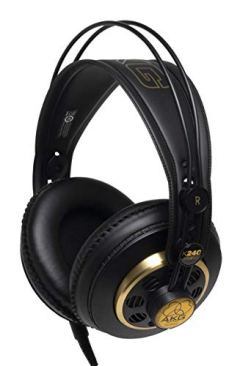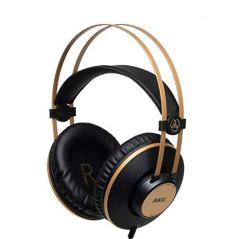BestReviews is reader-supported and may earn an affiliate commission. Details

Great looks mixed with a semi-open design deliver higher sound quality than the price would suggest.
We love how the semi-open back of each can make better range and dynamics in the music delivery.
Sound leakage is more prominent at higher volumes.

A great pair of good-looking headphones that offer a stylish accent when wearing them in public.
Excellent sound isolation is provided by the closed-back design of the ear cans.
Overall sound quality is a bit lackluster compared to other budget options.

A simple set of headphones that will provide you with top-quality sound at an affordable price.
High-quality and well-balanced sound quality. Great seal around ears. Adjustable to fit anyone.
Some did not find these as comfortable as other models.

A great headphone with a sleek, wireless design and minimal sound leakage.
Foldable for easy storage. Bluetooth features. Comfortable and produces clear, balanced sounds.
Headband adjustors were too loose for some.

One of the best studio headphones available on the market today.
A great combination of sound isolation mixed with more presence and volume in the overall sound quality.
Doesn't fare well as a set of mixing headphones for professional musicians and technicians.

We recommend these products based on an intensive research process that's designed to cut through the noise and find the top products in this space. Guided by experts, we spend hours looking into the factors that matter, to bring you these selections.

AKG is a prominent and prestigious name in professional audio equipment. Founded in Austria in 1947, AKG began as a maker of cinema equipment but pivoted into audio with its pioneering line of microphones. AKG moved into headphones for music recording and studio production, becoming famous for its open and semi-open full-size headphones with self-adjusting headbands. Bought by American audio hardware company Harman in the 1990s, it remains a subsidiary of Harman and its corporate parent, Samsung.
AKG headphones come in a variety of designs and configurations that reflect AKG’s studio engineering legacy as well as popular trends. While its professional headphone line continues to use tried and true technologies that have stood the test of time, it also offers models that compete in the consumer audio market, with wireless and noise-canceling headphones, neckbuds, true wireless earbuds, and in-ear monitors. It contributes expertise to Samsung for use in Samsung devices and to car maker Cadillac for use in its Escalade luxury SUVs.
AKG’s pro headphones are some of the best available, and its consumer models come in many styles and configurations. To choose what’s best for you, here are some considerations.

AKG headphones and earphones come in three different product lines:
Over-ear headphones are full-size headphones with large drivers and pads or cups that surround and enclose the ear. On-ear, or supra-aural, headphones have smaller drivers and pads or cups that rest on the outer ear. Earbuds either nestle in the outer ear or are inserted into the ear canal. Some find over-ear headphones the most comfortable and natural-sounding, but earbuds and on-ear headphones are less bulky, and individual comfort varies from person to person. AKG makes headphones and earphones in all three styles.
AKG’s full-size headphones are either open-backed, semi-open, or closed-back. Open-backed headphones allow air to pass through the ear cups. They produce the most accurate and highest-quality audio, but they offer no isolation — you can hear external sounds, and others can hear what you’re listening to.
Semi-open headphones are open headphones with some design obstructions to the airflow, offering a bit more isolation.
Closed-back headphones are sealed to the outside. They’re great for keeping your listening to yourself and seal off outside noise. However, they can get warm, and their audio is considered less natural than open and semi-open models.
Wired headphones remain preferred by audiophiles due to the higher fidelity possible over wired cables compared to common wireless technologies. However, the convenience of wireless connectivity and the increased audio quality and fidelity of standards such as Bluetooth have made wireless options many listeners’ headphones of choice. AKG offers wireless models in all its headphones series but has more wireless options in its N and Y series lines.
AKG stands for Akustische und Kino-Geräte Gesellschaft, or Acoustic and Cinema Equipment, reflecting its origins in movie speakers and projectors.
The AKG headband with its unmistakable silhouette has long been a signature feature of AKG pro headphones. Found on AKG’s K series, the AKG headband is designed to be self-adjusting, automatically conforming to the size of your head as you pull them over your ears. AKG’s N and Y series full-size headphones use more usual manually adjustable headbands, including ones that fold, an asset when it comes to portable storage.
The drivers (or transducers) of a headphone produce the sound. Generally, the larger the driver, the better. Most AKG over-ear and on-ear headphones use dynamic drivers, the most commonly used driver technology. Some high-end earbuds in AKG’s N series use hybrid drivers, combining a dynamic driver with small balanced armature drivers, allowing for impressive performance in a tiny size.
Impedance is a measure of headphones’ resistance to electric signals. While higher impedance can mean higher quality, lower impedance can be an asset for any headphones used with consumer electronics, like smartphones, tablets, and music players. Impedance is measured in ohms. AKG wireless headphones and earbuds in its Y and N series offer portable device-friendly impedance of 32 ohms or below, while its full-size and pro wired headphones can have more than 55 ohms impedance.
Frequency response refers to the range of frequencies headphones can emit. The wider the frequency range, the fuller and more complex the sound. The human ear can hear sounds in the range of 20 Hz to 20 kHz, but some headphones, including some of AKG’s K and N series models, have frequency ranges as low as 5 Hz — a bass that’s more felt than heard — and 54 kHz, which is higher than normal human hearing.
AKG usually uses detachable cables in its wired headphones. This allows the user to replace or swap them as needed. AKG’s K series headphone cables come in coiled or straight versions, with a Mini XLR plug at the ear cup and a headphone jack at the other end, usually a standard 3.5-millimeter plug. Wired headphones in its N series have 3.5-millimeter plugs at both ends. They often sport inline remotes.
Many popular headphones and earphones on the market offer active noise cancellation, or ANC, which uses technology to cancel out external sound. AKG N series headphones offer several models of both wired and wireless full-size and earbud-style headphones with active noise cancellation. While some audiophiles feel ANC takes away from a pure listening experience, it can be a key feature if you travel frequently, especially on planes, or want to block out the sounds of the world around you.

Many audio enthusiasts swear by the use of DACs (digital-analog converters) and amplifiers to improve the quality of the signals sent to headphones. AKG’s K series headphones with their high impedance can benefit by plugging an amplifier between it and the audio source. Mini headphone amplifiers can fit on your desk or even in your pocket.
AKG offers alternative and replacement cables for its wired headphones. You can swap a 3-meter coiled cable for a 1.5-meter straight cable, or swap between a cable with and without an inline remote. You may also consider getting a headphone jack adapter, such as a 3.5-millimeter to 1/4-inch stereo plug, a plane audio adapter, or a USB-C audio adapter. To share a wired connection, consider an audio splitter.
The ear pads on any full-size on-ear or over-ear headphones eventually wear out. AKG K series headphones have replaceable ear pads that can be purchased from the company or through audio equipment dealers.
Several of AKG’s most popular K series models cost less than $100. These are great buys if you appreciate pure audio quality, but they aren’t very portable, have open or semi-open backs, and lack wireless connectivity and noise cancellation.
AKG prices many models between $100 and $350. These include the bulk of its N series premium consumer headphones, including its wireless noise-canceling models, as well as its colorful Y series.
AKG’s highest-priced models range from $400 to over $1,500. These include reference-class multi-driver in-ear monitors, the highest-end studio reference monitors in its K series, and models developed in association with legendary music producer Quincy Jones.
Frequency response is measured on a response curve. A flat or “neutral” response curve is preferred for audio engineering and mixing, while many consumers prefer a “colored” response with boosted bass and/or treble frequencies.

A. AKG K series headphones are widely known and respected in studio recording and among audiophiles, but they may be even more famous for their microphones. AKG’s N and Y series consumer headphones are not quite as well-known as competitors like Bose and Sony but are generally well-reviewed, with individual models being highly praised.
A. AKG headphones are currently made in China. For many years, AKG products were made in Austria, where the company was founded. AKG closed its manufacturing facilities in Austria in 2017. Other AKG products are made in Hungary.
A. Models of Samsung’s Galaxy S line came with earbuds “tuned by AKG” as recently as the Galaxy S20 series, introduced in 2020. Samsung sells USB-C wired earbuds with AKG branding. Samsung’s Galaxy Tab S series tablets have speakers tuned by AKG.
Get emails you’ll love.
Learn about the products you’re wondering if you should buy and get advice on using your latest purchases.
